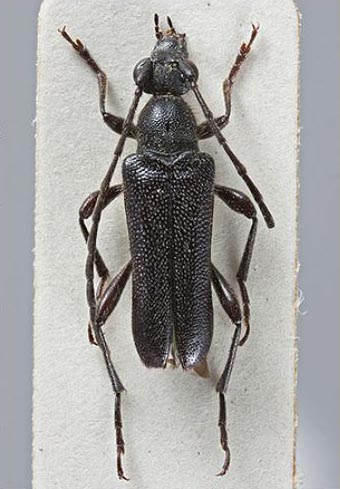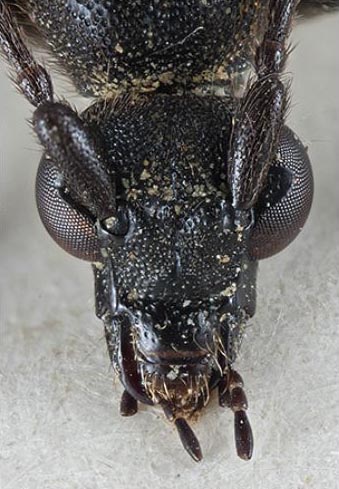 |
Lepturinae
Classification
Introduction
- The subfamily Lepturinae Latreille, 1802 currently contains ~1,300 species in 9 tribes. Photographs of 32 exemplar specimens are currently available for this subfamily.
Diagnostic Features of Adults
- Mesoscutum with divided stridulatory file. Ventral mesotarsal lobes on antepenultimate tarsomere only. Antennae borne on raised tubercles. Anterior portion of prosternum at midline shorter than prosternal process (Lawrence, 2007).
Diagnostic Features of Larvae
- Larva. Form subcylindrical to strongly depressed. Head slightly to strongly transverse; epicranial halves entirely separated behind frons (except in a few exotic species); occipital foramen not divided into an anterior and posterior portion, as the tentorial cross-arm is internal; postero-dorsal emargination very strong, extending to frons; front margin of frons never steeply declivous or projecting over clypeus, and with six to ten (occasionally as many as 20) epistomal setae. Clypeus trapezoidal, as wide at base as front margin of frons. Labrum transverse, semicircular or cordate. Mandibles with an oblique cutting edge, apex acutely produced. Ocelli absent, or one to six pairs present. Antenna very small, retractile, and two- or three-segmented. Maxillae movable; palpifer with outer margin straight, and bearing lobe. Ligula larger than labial palpi. Prothorax with eusternum distinct, triangular. Abdomen with ampullae tuberculate; epipleuron strongly protuberant on all segments, but region surrounding spiracle not protuberant; pleural discs absent; ninth segment sometimes with a terminal spine or urogomphi. Legs slender and rather Jong; coxae large, almost touching inwardly between eusternum and sternelum; unguiculus with a Jong stout seta arising near base. Spiracles of mesothorax not protruding into prothorax; all spiracles with small, nearly contiguous marginal chambers. Adapted from Duffy (1953).
Geographic Distribution of Subfamily
Biology and Economic Importance
- Larvae of most species develop for about one year in the trunk or branches of dead trees (or dead portions of leaving trees). Some species can have two broods per year. Adults are relatively short lived, probably most living less than 1 month. Most feed conspicuously on flowers as adults and thus are important pollinators (summarized from Linsley, 1961; Lawrence, 2007, and other sources).
Selected References to Adult Specimens
Selected References to Larvae Specimens
|  |

Anoplodera (Anoploderomorpha) monticola
(Nakane, 1955); dorsal
Cerambycidae:Lepturinae
Photograph © N.P. Lord

Anoplodera (Anoploderomorpha) monticola
(Nakane, 1955); head
Cerambycidae:Lepturinae
Photograph © N.P. Lord

Anoplodera (Anoploderomorpha) monticola
(Nakane, 1955); lateral
Cerambycidae:Lepturinae
Photograph © N.P. Lord
|




